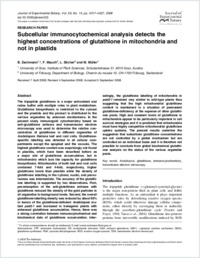Subcellular immunocytochemical analysis detects the highest concentrations of glutathione in mitochondria and not in plastids
- Zechmann, B. University of Graz, Institute of Plant Sciences, Graz, Austria
- Mauch, Felix University of Fribourg, Department of Biology, Fribourg, Switzerland
- Sticher, Liliane University of Fribourg, Department of Biology, Fribourg, Switzerland
- Müller, M. University of Graz, Institute of Plant Sciences, Graz, Austria
-
05.09.2008
Published in:
- Journal of Experimental Botany. - 2008, vol. 59, no. 14, p. 4017-4027
English
The tripeptide glutathione is a major antioxidant and redox buffer with multiple roles in plant metabolism. Glutathione biosynthesis is restricted to the cytosol and the plastids and the product is distributed to the various organelles by unknown mechanisms. In the present study immunogold cytochemistry based on anti-glutathione antisera and transmission electron microscopy was used to determine the relative concentration of glutathione in different organelles of Arabidopsis thaliana leaf and root cells. Glutathione-specific labelling was detected in all cellular compartments except the apoplast and the vacuole. The highest glutathione content was surprisingly not found in plastids, which have been described before as a major site of glutathione accumulation, but in mitochondria which lack the capacity for glutathione biosynthesis. Mitochondria of both leaf and root cells contained 7-fold and 4-fold, respectively, higher glutathione levels than plastids while the density of glutathione labelling in the cytosol, nuclei, and peroxisomes was intermediate. The accuracy of the glutathione labelling is supported by two observations. First, pre-adsorption of the anti-glutathione antisera with glutathione reduced the density of the gold particles in all organelles to background levels. Second, the overall glutathione-labelling density was reduced by about 90% in leaves of the glutathione-deficient Arabidopsis mutant pad2- 1 and increased in transgenic plants with enhanced glutathione accumulation. Hence, there was a strong correlation between immunocytochemical and biochemical data of glutathione accumulation. Interestingly, the glutathione labelling of mitochondria in pad2-1 remained very similar to wild-type plants thus suggesting that the high mitochondrial glutathione content is maintained in a situation of permanent glutathione-deficiency at the expense of other glutathione pools. High and constant levels of glutathione in mitochondria appear to be particularly important in cell survival strategies and it is predicted that mitochondria must have highly competitive mitochondrial glutathione uptake systems. The present results underline the suggestion that subcellular glutathione concentrations are not controlled by a global mechanism but are controlled on an individual basis and it is therefore not possible to conclude from global biochemical glutathione analysis on the status of the various organellar pools.
- Faculty
- Faculté des sciences et de médecine
- Department
- Département de Biologie
- Language
-
- English
- Classification
- Biological sciences
- License
-
License undefined
- Identifiers
-
- RERO DOC 10818
- DOI 10.1093/jxb/ern243
- Persistent URL
- https://folia.unifr.ch/unifr/documents/301002
Statistics
Document views: 126
File downloads:
- Document: 173
